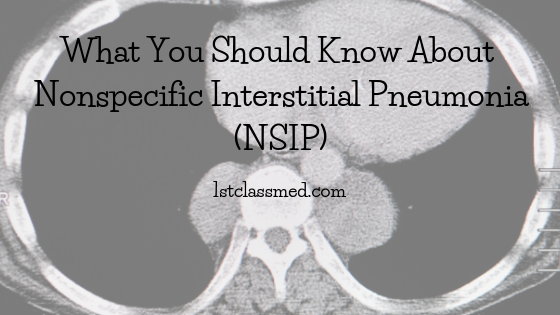
Nonspecific interstitial pneumonia (NSIP) is a rare disorder that affects tissue in the lungs.
NSIP specifically affects the tissue that surrounds (and separates) the alveoli in the lungs.
The alveoli are where oxygen (that we breathe in) and carbon dioxide (released from our organs into our bloodstream) is exchanged.
Interstitial pneumonia is a disease where the walls of the alveoli become very inflamed, which can be painful and make breathing hard.
NSIP can occur from multiple different diseases, such as connective tissue disorders, medication reactions, and HIV.
Many individuals have idiopathic NSIP, meaning that there is no specific known cause of the lung disease.
Two Forms of NSIP:
There are two main forms of NSIP, cellular and fibrotic.
Fibrotic is much more common than cellular NSIP.
Cellular NSIP is often inflammation of the cells in the interstitium (fluid-filled space between alveolar membranes and the interstitial capillaries).
Fibrotic NSIP is when the lung tissue begins to scar and thicken.
The scarring (fibrosis) is irreversible and can cause lungs to work less efficiently, reducing the levels of oxygen in the blood.
The prognosis is often better for those who are diagnosed with the cellular form of NSIP.
Symptoms of Nonspecific Interstitial Pneumonia
Though these symptoms are common for those with NSIP, you may have different symptoms, if you notice anything abnormal, make an appointment with your doctor.
- A dry cough
- Shortness of breath
- Difficulty breathing
- Fatigue
- Weight loss
Causes of Nonspecific Interstitial Pneumonia
There is currently no known cause, but research is pointing to autoimmune diseases.
This is believed because there are many similarities between NSIP and connective tissue diseases.
Other research is pointing to genetics and heredity playing a role in the development of NSIP.
Inhalation of chemicals, some chemotherapy drugs or radiation can result in lung damage common with NSIP.
Though research is pointing to a few different causes, there is not enough conclusive research to blame a specific cause at this time.
Diagnosis of Nonspecific Interstitial Pneumonia
As the symptoms of NSIP are similar to other diseases, meeting with your doctor when you notice any abnormal symptoms is important.
There also may be many tests done in order to rule out any other disease or disorder.
Tests such as pulmonary function tests, CT scans, and occasionally bronchoscopy may all be done to determine the cause.
Some of these tests can be hard to find results, even with high-resolution CT scans, seeing NSIP can be extremely difficult.
If none of the tests show definitive results or they are too hard to read, a lung biopsy may be done to look at the tissue for any signs of inflammation or scarring.
A proper diagnosis will often include many skilled and experienced doctors, radiologists and pathologists that all come to the same conclusion.
The only way to get a full clinical diagnosis requires a lung biopsy of the affected lung tissue.
Treatment for Nonspecific Interstitial Pneumonia
For those with cellular NSIP, treatment with oral corticosteroids tends to have a positive response.
If there is a poor response from oral corticosteroids there may be a need for immune-suppressing drugs.
Patients with fibrotic NSIP will not always respond to corticosteroids or immune-suppressing drugs on their own, so often both drugs are use in conjunction with each other.
The goal for fibrosis NSIP is to prevent any further irreversible fibrosis in the lungs.
If there is an underlying disease causing NSIP, your medical team may want to treat that before focusing on the NSIP itself.
The prognosis for those with cellular NSIP is very good, as there is a very low morality rate.
For fibrotic NSIP, the prognosis is a bit lower, with an average survival rate between 6 to 13.5 years after original diagnosis.
Conclusion
A diagnosis of cellular nonspecific interstitial pneumonia is commonly an easily treated condition, with the outcome at a low morality rate.
For a diagnosis of fibrosis nonspecific interstitial pneumonia, the outcome has a higher morality rate, but can still be treated (often to prevent any further fibrosis in the lungs).
The causes of nonspecific interstitial pneumonia (both forms) are still unknown, but research is pointing to autoimmune diseases.
Diagnosis of NSIP can also be extremely difficult, as noninvasive methods do not always provide conclusive result.
Most often for a NSIP diagnosis a lung biopsy will need to be preformed to get conclusive results.
Treatment for each form of NSIP is extremely similar but may not yield the expected results.
Occasionally for treatment your medical team may plan to treat an underlying condition (if you have one).
The outcome of treatment changes for every individual, some may have more successful result compared to others.
Your doctor will give you a prognosis based on your personal health and situation.



